Enrichment is vital for all dogs, but the same-old toys and scenery at home get dull. Unfortunately, not every pooch (or pup parent) is a fan of dog parks, and even dogs who do like parks may get bored, as relatively few of them feature a menagerie of playthings to enjoy.
Thankfully, you can craft a DIY dog playground right in your backyard! And best of all, you can tailor it to your doggo’s likes, dislikes, and physical needs, ensuring he has the most fun possible.
We’ll share some of our favorite DIY dog playground ideas and provide some general doggy playground tips and tricks below.
Key Takeaways: How to Make a DIY Dog Playground
- Creating a DIY dog playground doesn’t need to be difficult or expensive. Often, you can build a fun fur-kid setup pretty quickly, using products you have on hand or with low-cost supplies.
- Keep your canine’s interests and abilities in mind. Not every dog will be able to balance across an elevated dog walk or enjoy splashing in the water, so think of your dog’s likes and dislikes before deciding on a project.
- Implement common-sense safety measures. Improper assembly or unsupervised play can lead to serious injuries, so be sure to keep safety in mind when hooking up your hound with some backyard playground gear.
Pupper playgrounds and DIY dog agility courses have a lot of similarities, but they also have a few key differences.
For starters, agility courses typically include a few pretty standard features, such as weave poles, chutes, and agility tunnels. Playgrounds, on the other hand, can feature just about anything your four-footer will find fun — there are no rules for playgrounds (aside from keeping your doggo safe).
Both types of animal attractions can be valuable additions to your backyard, but just think about your goals before you get started.
If you’re interested in turning your pet into a canine athlete, an agility course is likely the best option; if you just want Fido to have some fun, then a playground would be ideal.
23 DIY Dog Playground Ideas for Your Backyard
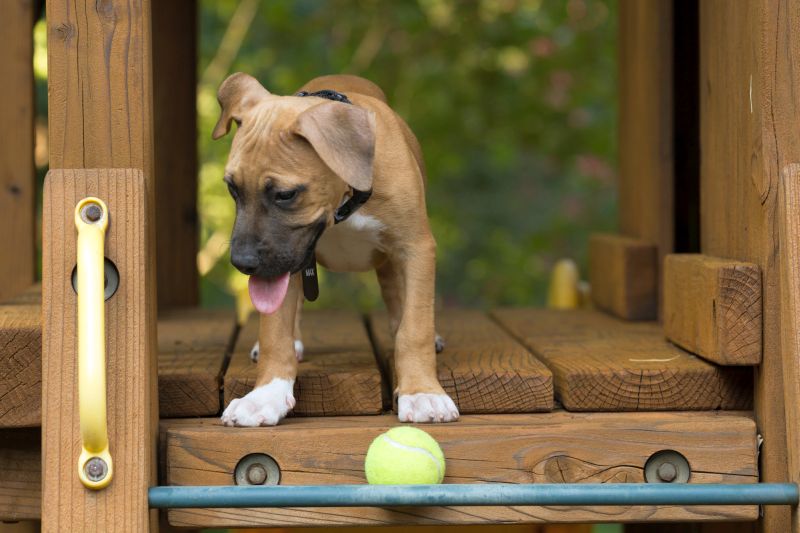
The secret to building the best DIY dog playground is to select designs your dog will enjoy best. We’ve rounded up various designs to cover all canine interests, from watersports to sniffing stations.
We’ve also included a grading system covering installation difficulty, cost, and doggy satisfaction, as well as which dogs each design might work for and which dogs might want to skip them.
1. Dog Pool
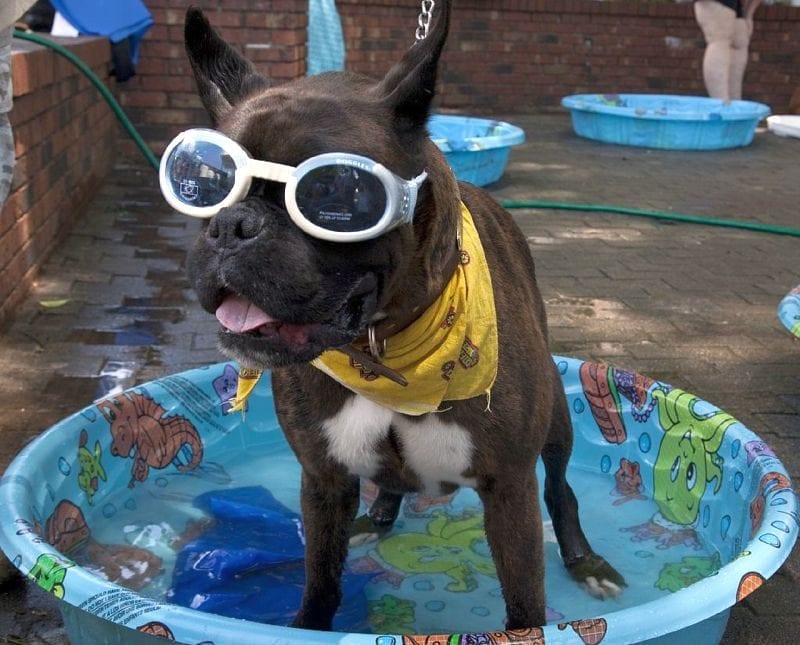
Not every dog loves water, but dog pools are instant favorites for fans of the wet stuff. It’s a relatively low-impact activity, and soaking can soothe sore joints, making it an excellent choice for older dogs.
You can purchase a premade pet-safe pool for relatively little cash (be sure to check out our article on the best dog pools to see some options), and most need little, if any, assembly. These also take up relatively little room, allowing you to retain yard space for more activities.
Always monitor your dog when he’s enjoying his pool, and drain the water when the pool isn’t in use. Filled, unattended pools are risky for kids and pets and can be a breeding ground for mosquitoes.
Add ice cubes or floating toys to your pup’s pool for added enrichment. Sliced apples also make a tasty addition. Just be sure to remove any uneaten ones once playtime is over.
Difficulty Level: ★
Cost: ★★
Doggo-Enjoyment: ★★★★
Best For: Water lovers, dogs with joint issues, and dogs in hot weather
Not Ideal For: Dogs who dislike water and dogs living in cold climates
2. Balance Beam
Some canine athletes love the challenge of crossing a balance beam. You can build your own out of wood for relatively cheap (check the video above to learn how), or purchase a premade balance beam from GymsForDogs, but this option is on the pricier side. If building your own, we wouldn’t recommend making it more than 2 feet high, depending on your dog’s size. There’s no need to risk your dog falling from a great height and getting injured.
Balance beams are a great option for agility all-stars, but we wouldn’t recommend them for older dogs or those with joint or mobility issues. And while a balance beam is a fun challenge for some pooches, it isn’t as likely to get your dog’s brain buzzing as some other activities are.
Difficulty Level: ★★★
Cost: ★★ – ★★★★★
Doggo-Enjoyment: ★★
Best For: Agility stars and young dogs
Not Ideal For: Older dogs and those with joint issues
3. Teeter-Totter
As with balance beams, teeter-totters (AKA seesaws) are favorites amongst the agility crowd. Young pups seem to get a kick out of the movement, but skittish canines might find them too scary. You can purchase a premade dog teeter-totter that requires no assembly or build your own using PVC, as seen in the video above.
Dog seesaws are fine for use in multi-dog households, but always be ready to play referee, just in case one barker is more boisterous than the other and inadvertently sends a fur friend flying.
Difficulty Level: ★★★
Cost: ★★
Doggo-Enjoyment: ★★
Best For: Agility stars and young dogs
Not Ideal For: Older dogs, dogs with joint issues, and skittish dogs
4. Tire Tunnel
Tire tunnels are a labor of love that can take up a fair amount of backyard space, but they’re well worth the effort for agility lovers and curious canines. These tunnels are fun to explore and give your dog a cool place to chill when he’s feeling tuckered out from play. Most four-footers love tunnels, but they may not be the best option for skittish sniffers or those with joint and mobility issues.
Making your own tire tunnel (as explained in the above video) is easier than you’d think, and you can customize the layout, whether you’d like a small chute or a large, curved design. Tire tunnels also last a while and can withstand the elements better than wooden play structures. Eco-conscious humans also love the thought of recycling old tires for a new, fun project.
Difficulty Level: ★★★
Cost: ★★
Doggo-Enjoyment: ★★★
Best For: Agility stars, curious canines, and terriers
Not Ideal For: Dogs with joint issues and skittish dogs
5. Sandbox
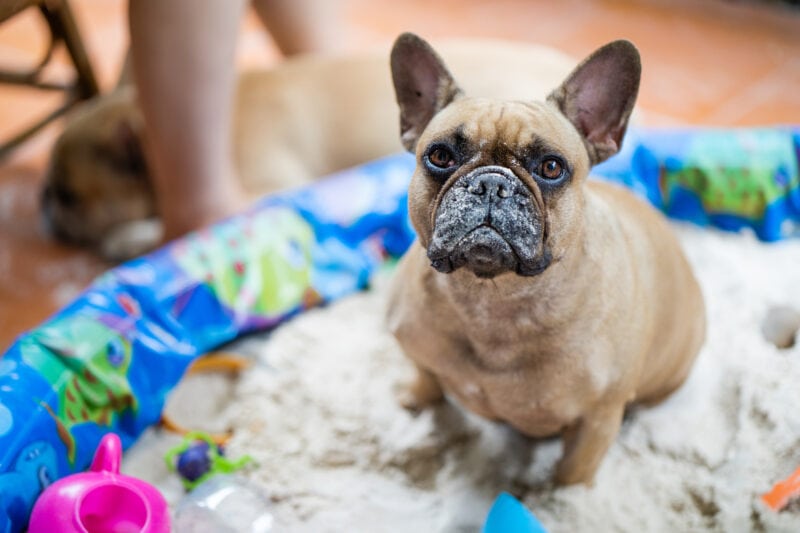
Digging is a natural canine behavior, particularly in tunneling breeds like dachshunds. Accordingly, sandboxes can be safe, much-needed outlets for this instinct.
You can make your own sandbox by digging out an area and filling it with sand, or you can purchase a premade sandbox and fill it with play-safe sand. Don’t use just any soil at the store, as many are treated with chemicals that can be toxic to dogs.
Always use a cover for your dog’s sandbox when it’s not in use, as cats tend to use them as litter boxes, and your pooch can catch parasites and other illnesses from their droppings. Most dogs love digging, but if your floof is fussy about getting dirty, this might not be the option for him.
Bury some of your dog’s favorite treats just beneath the surface of the sand to really get him digging.
Difficulty Level: ★★
Cost: ★★
Doggo-Enjoyment: ★★★
Best For: Digging breeds and terriers
Not Ideal For: Finicky Fidos
6. Weave Poles
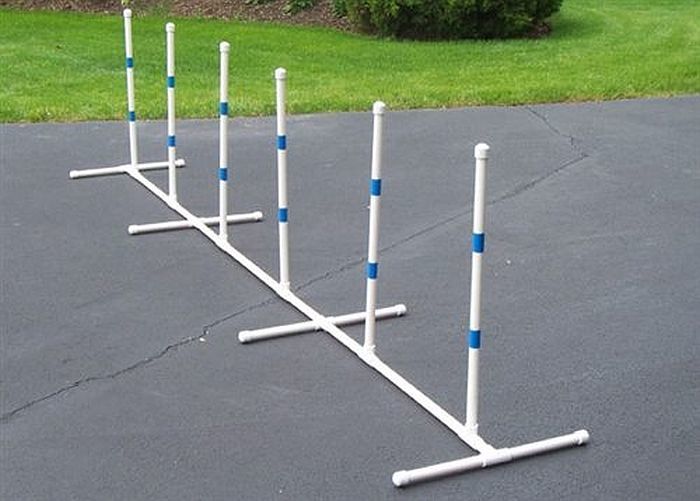
Weave poles are a no-brainer for agility-lovin’ four-footers. The weaving action requires focus, a fast pace, and a degree of athleticism, so these are best suited for sportier breeds and young pups. Not every dog is interested in the activity, however, and we wouldn’t recommend weave poles for dogs with joint or mobility issues.
You can make DIY PVC weave poles at home with some elbow grease, or you can purchase a premade set if you’re not a building extraordinaire. If your dog competes in agility trials, stick to AKC regulations for spacing to ensure proper mastery.
Difficulty Level: ★★
Cost: ★★
Doggo-Enjoyment: ★★
Best For: Agility stars and young pups
Not Ideal For: Dogs with joint issues, skittish dogs, and couch potato canines
7. Agility Jumps
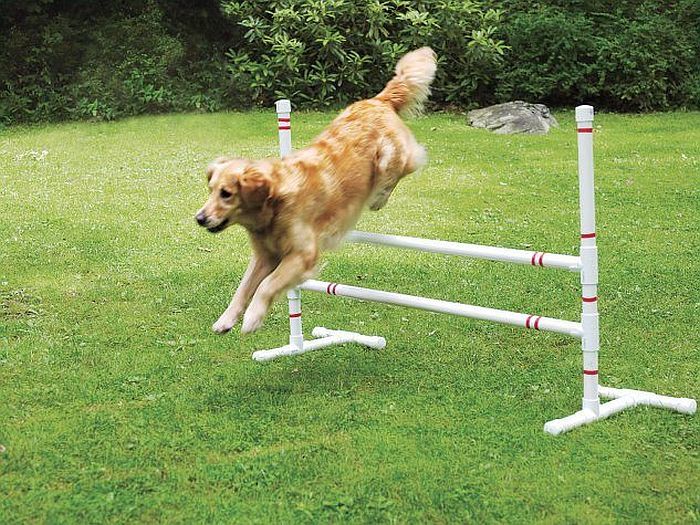
Jumps are beloved by canine athletes and burn off a great deal of energy, making them a must-have for those with high-octane four-footers. They’re also less labor-intensive to assemble than other agility equipment and don’t take up much room. You can make a DIY agility jump using PVC relatively easily, or you can purchase a premade adjustable jump for convenience.
Agility jumps are best for younger, athletically-inclined dogs. But on the flip side, they are not recommended for older dogs or those with a history of joint issues or injury. Always err on the side of caution when selecting a height, and always keep both the takeoff and landing zones free of debris and uneven soil.
Difficulty Level: ★★
Cost: ★★
Doggo-Enjoyment: ★★
Best For: Agility stars and young dogs
Not Ideal For: Dogs with joint issues, couch potatoes, and skittish dogs
8. A-Frame
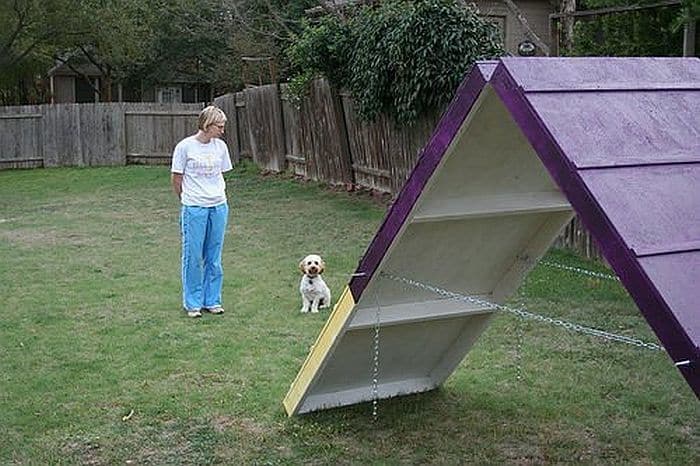
The A-frame is an agility course staple that offers a fun climbing challenge to your dog. There is the physical hurdle of climbing to overcome, of course, along with the mental aspect of scaling and descending a strange object. Young dogs and agility all-stars will relish the task, but understand that older dogs, couch potatoes, and skittish canines may avoid these obstacles entirely.
Purchasing a premade agility A-frame is pricey, but you can make a DIY version at home for far less money if you’re handy. Be warned: This is one of the most challenging builds on our list, but it’s a great way to save some money if you know your way around tools.
Difficulty Level: ★★★★
Cost: ★★ – ★★★★★
Doggo-Enjoyment: ★★★
Best For: Agility stars and young dogs
Not Ideal For: Dogs with joint issues, skittish dogs, and couch potatoes
9. PVC Play Gym
PVC play gyms feature toys suspended from a PVC structure, giving your dog a chance to tug, shake, and play to his heart’s content. A staple in rescue circles, these provide crucial physical and mental exercise to growing puppies and can help small breeds squeeze in some playtime when confined to compact spaces.
Building a DIY PVC play gym isn’t too tricky, and you can customize the toys to your pup’s liking and needs, making it a great choice. But while they can be durable, we wouldn’t recommend these for use with large, strong breeds that may break the setup.
Add toys with varying textures and noisemakers to the play gym to give your dog an extra-special sensory experience. Hidden treats are also appreciated.
Difficulty Level: ★★★
Cost: ★★
Doggo-Enjoyment: ★★★★★
Best For: Puppies, Small dogs
Not Ideal For: Strong dogs
10. Snuffle Mat Station
Your dog learns a lot through his nose, and a snuffle or sniff mat can put his sniffer to use. Just add your dog’s favorite treats to these textured creations, and let him explore. Indoors, you’re somewhat limited in what you can add to a sniff mat for your own nose’s sake, but outdoors, you can add all sorts of stinky treats, like Limburger cheese bits.
You can purchase one of the best snuffle mats or go the DIY route (there are plans in the linked article). Sniff mats are a great option for most dogs, including older pups who may struggle to get out for mentally stimulating walks. Unfortunately, we wouldn’t recommend sniff mats for shredders, as these pups sometimes focus more on destruction than finding the goodies.
Difficulty Level: ★
Cost: ★
Doggo-Enjoyment: ★★★★★
Best For: Most dogs, scent hounds, and older canines
Not Ideal For: Shredders
11. Splash Pad
Splash pads are the ultimate in canine water fun. Unlike pools where your dog is pretty much limited to soaking or swimming, dog splash pads are interactive with water spouts that may be continuous or intermittent.
A splash pad is a must-have if your dog loves water, but those who hate the wet stuff won’t be fans.
Doggy splash pads can be built using step-sprinklers on grass or purchased as a splash-pool combo. You can also opt for a fancier permanent setup, but a DIY concrete splash pad (like the one in the video above) can be expensive and difficult to assemble.
Don’t let your dog gobble too much water while playing with a splash pad or swimming. Also, allow him plenty of time to dry off thoroughly and piddle outdoors afterward to avoid hot spots and indoor accidents.
Difficulty Level: ★ – ★★★★★
Cost: ★ – ★★★★★
Doggo-Enjoyment: ★★★★★
Best For: Water lovers, young dogs, and dogs in hot weather
Not Ideal For: Dogs who dislike water and those living in cold climates
12. Doggy Ball Pit
A DIY doggy ball pit is the perfect way to burn off energy, indoors or outdoors! Supplies are affordable and easy to come by, including both the basins and the balls you’ll need to set it up. You can also use a large plastic tub as your ball pit or repurpose an old kiddie pool or sandbox. These are sometimes available on resale sites for relatively cheap, saving you cash.
A DIY ball pit is perfect for digging doggos and those who are ball obsessed. Most dogs will enjoy rooting through the balls, though we’d avoid these with super chewers who may try to pop and/or eat balls. Most balls are about 2.3 inches in diameter but opt for larger balls for big dogs to avoid a choking hazard.
Sprinkle some kibble or your dog’s favorite treats into the ball pit to keep him sniffing and engaged. A favorite toy or two won’t hurt either!
Difficulty Level: ★
Cost: ★★
Doggo-Enjoyment: ★★★
Best For: Terriers, retrievers, and other ball-obsessed doggos
Not Ideal For: Super chewers
13. Spring Pole
Few pup playground activities are as action-packed as the spring pole. These toys feature a rope or toy dangling from a spring coil, letting your dog leap, tug, and twist to his heart’s content. Bully breeds are especially fans of spring poles, but they’re also great for other high-energy dogs like Jack Russells, Labradors, and shepherds. However, we don’t recommend spring poles to dogs with joint issues or those prone to injury.
The easiest route is to purchase a pre-assembled spring pole for installation, but you can build a DIY spring pole. This lets you customize the toy and design to your dog’s liking and size.
Difficulty Level: ★★
Cost: ★★★
Doggo-Enjoyment: ★★★★
Best For: Young dogs, bully breeds, and fans of tug-of-war
Not Ideal For: Dogs with joint issues and those prone to injury
14. Hound Hammock
Backyard fun and enrichment aren’t limited to crazy activities. It also means hanging out and soaking up the sights and sounds of nature. A DIY doggy hammock lets your four-footer do just that in a comfortable, supportive sling.
Older dogs will appreciate a new lounging spot, but we wouldn’t suggest a hammock for dogs who shred fabrics, as your pup may spend his time destroying your newest creation instead of laying in it. Double-check weight limits on any DIY design to make sure it fits your floof’s frame too.
Rover reluctant to climb aboard his new hammock? Sprinkle some of your dog’s favorite treats on the hammock to entice him to climb in. For best results, avoid forcing him to use the hammock and maintain a positive attitude.
Difficulty Level: ★★
Cost: ★★
Doggo-Enjoyment: ★★★★
Best For: Older dogs
Not Ideal For: Shredders
15. Canine Swing
A dog swing is a fun place for your pup to unwind during backyard play. Most dogs don’t like swinging on them like a traditional swing; instead, they prefer sitting on them like a hammock. This may not seem fun to us humans, but it’s another piece of equipment for your dog to interact with, so it may be a worthy addition. While most pooches can easily use a canine swing, they aren’t a good pick for dogs with joint issues.
This DIY dog swing is somewhat easy to assemble, though some are only appropriate for small dogs. You can also opt for a DIY saucer-style swing for larger dogs.
Difficulty Level: ★★★
Cost: ★★
Doggo-Enjoyment: ★★
Best For: Young pups and daredevil doggos
Not Ideal For: Dogs with joint issues
16. Cool-Down Cube
Almost every dog loves snacks, and a DIY cool-down cube offers that. Just gather your dog’s favorite goodies, add them to a large freezable container with water, freeze, and serve. Your dog will lick and sniff up a storm, eventually reaching the tasty treasures inside. Feel free to experiment with other dog-friendly ice block treat recipes.
Cool-down cubes are perfect for dogs in hot climates and let every doggo get in on the fun, including those with joint issues. The only pups we wouldn’t recommend them to are super chewers who may try to bite off more than they can chew (literally) and break a tooth.
Difficulty Level: ★
Cost: ★
Doggo-Enjoyment: ★★★★★
Best For: Most dogs, but especially canines living in hot climates
Not Ideal For: Super chewers
17. Doggy Slide
Believe it or not, some dogs love slides. We wouldn’t recommend installing a full-blown playground slide for safety and space’s sake, but if you think your dog might enjoy sliding, try a toddler slide. You can purchase these premade for relatively cheap, though you should never allow your four-footer to chew the plastic material.
We recommend a premade plastic slide over a homemade wooden one, as plastic slides rinse easily with a hose and are often lightweight and foldable for when they’re not in use. Just watch for weight restrictions, and keep your dog’s physical form in mind. Dogs who are older or injury-prone should sit this activity out.
Difficulty Level: ★
Cost: ★★
Doggo-Enjoyment: ★★
Best For: Young pups and daredevil doggos
Not Ideal For: Older dogs and those with joint issues
18. Hula Hoop Loop
Hula hoop loops function as a traditional agility jump, giving your dog a new obstacle to hop through. These are best for athletic four-footers and aren’t suggested for dogs with joint issues or those who are skittish.
Check out this hula hoop loop design using hula hoops, PVC pipe, and zip ties for a quick DIY hoop jump. It’s an easy setup that doesn’t require any complicated cutting, so it’s a good choice for newbie DIYers.
Difficulty Level: ★★
Cost: ★★
Doggo-Enjoyment: ★★
Best For: Agility lovers and young dogs
Not Ideal For: Dogs with joint issues, skittish dogs, and canine couch potatoes
19. Tunnel Chute
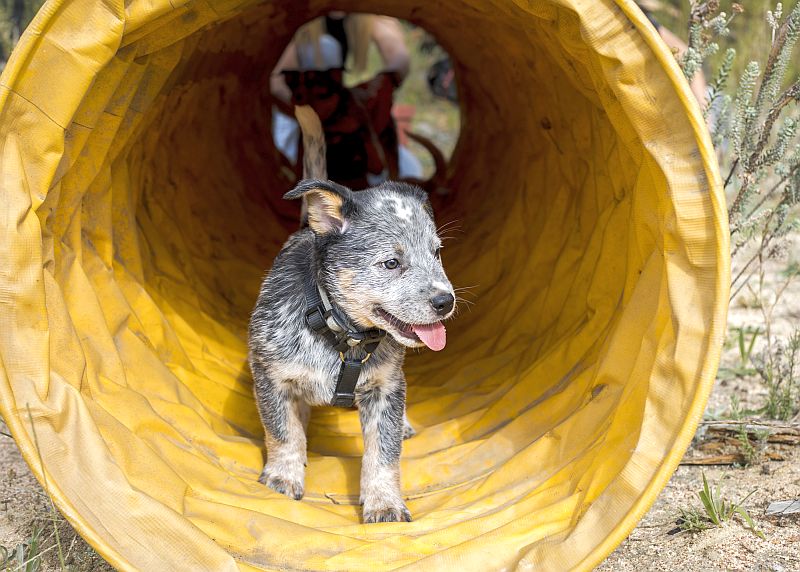
Tunnel chutes are a fun pass-through for high-energy puppers – especially those in agility circles. Featuring a traditional tunnel opening with a fabric exit, most dogs will get the hang of them, but if your pup is skittish, he may not be a fan. Also, note that shredders may be more interesting in tearing up the fabric portion than using the chute as intended.
This DIY dog agility chute can be made with items you might have in your garage, but it is a bit labor-intensive. If you aren’t convinced you can pull it off, you can also purchase a premade dog tunnel for agility.
Difficulty Level: ★★★
Cost: ★★
Doggo-Enjoyment: ★★
Best For: Agility lovers and active dogs
Not Ideal For: Skittish dogs and shredders
20. Tug Tetherball
Tug-of-war is a favorite pastime for most dogs, but it can be a real pain in the arm for us pup parents. Tug Tetherball is the perfect remedy, allowing your dog to play tug with himself until he’s worn out and ready for a nap. Young dogs and canine athletes are usually a fan of tug games, but they aren’t a good idea for dogs with dental issues.
This DIY Tug Tetherball (like the one in the video above) is easy to assemble and affordable. You won’t need any heavy-duty tools, either.
Difficulty Level: ★★
Cost: ★
Doggo-Enjoyment: ★★★★★
Best For: Fans of tug-of-war and young dogs
Not Ideal For: Dogs with dental issues
21. Pause Table
Pause tables are regularly seen on agility courses, but these elevated platforms can add to your dog’s backyard enrichment. They’re fun to climb and give your pupper a lookout point, which is often a hit with small breeds. While easy for most dogs to navigate, they aren’t suggested for dogs with joint issues.
This DIY pause table in the video above features artificial turf for a more natural feel, but it does require some building skills and tool work. It’s more affordable than purchasing most pre-made tables, however.
Difficulty Level: ★★★
Cost: ★★
Doggo-Enjoyment: ★★★
Best For: Climbing canines, couch potatoes, and daredevil dogs
Not Ideal For: Dogs with joint issues
22. DIY Dog Walk
The dog walk lets your dog strut his stuff high in the sky, but purchasing a readily-made one is pricey. Luckily, you can make a DIY dog walk (just check the video above) if you know your way around a tool shed. Dog walks take up a decent chunk of yard real estate and usually don’t fold up, so make sure you have the space to dedicate to one before starting your build.
Most dogs can learn to use a dog walk just fine, but we wouldn’t recommend them for dogs with joint or balance issues for obvious reasons.
Difficulty Level: ★★★★
Cost: ★★
Doggo-Enjoyment: ★★★
Best For: Agility lovers and daredevil dogs
Not Ideal For: Dogs with joint issues
23. Toy Tangle

Put your barker’s brain to work by creating a massive toy tangle for him to unravel. Take a span of rope and loosely loop/tie it around your dog’s favorite toys or add in some new ones to really ramp up the fun. Don’t shy away from adding food-stuffed chew toys for added motivation. Space the toys out every few feet for the best results. You can either coil the rope, toss it in a tangle, or stretch it across the yard for your dog to explore.
As with any piece of play equipment, monitor your dog while he unravels the toy tangle. Any dog can use a toy tangle, but it might be more of a mess for rope shredders than you’d like.
Difficulty Level: ★
Cost: ★
Doggo-Enjoyment: ★★★★★
Best For: Puzzle lovers and toy-crazed canines
Not Ideal For: Shredders
DIY Dog Playgrounds: Tips and Tricks
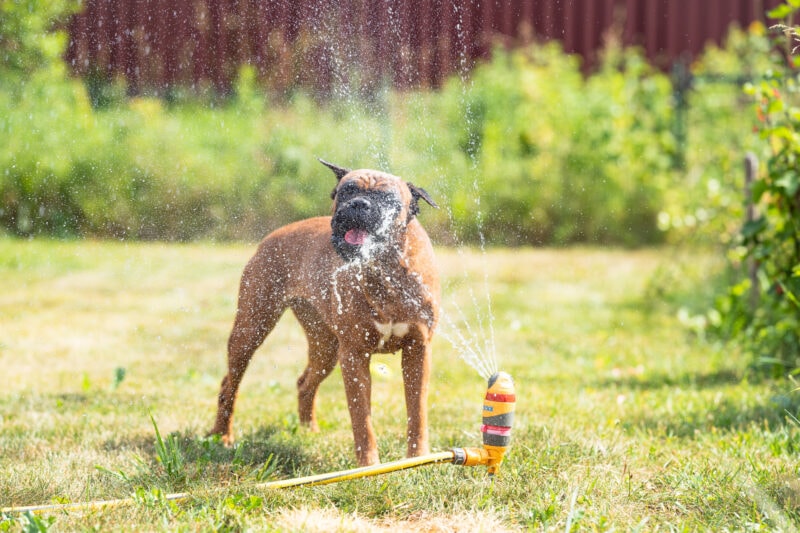
Adding a DIY dog playground to your yard is a fun way to bond with your fur kid and introduce more fun into his day-to-day life. While the playthings are fun on their own, there are ways to make the experience even better for your dog.
To make the most of your DIY dog playground:
- Add food. Almost every dog (and person) would agree that food makes everything better. So, keep some high-value dog training treats on hand and implement them into your pup’s new adventure. Hidden treats are especially appreciated and add a sensory aspect to play.
- Experiment. Don’t commit to any massive backyard builds before knowing what your dog likes. For instance, you want to bring the hose out for some pupper play to see how he reacts to some splish-splashing before installing a splash pad.
- Keep it positive. New equipment and experiences can be scary to dogs. Be patient with your pup, and don’t force him to do anything he isn’t comfortable with. Kind words and treats go a lot farther than yelling.
Also, follow these simple rules to keep everyone safe and allow the fun to continue:
- Don’t leave your dog unattended. This is especially important around water or ball pits. Accidents happen, and it’s best if you’re there to help out.
- Drain any water sources thoroughly after use. Unattended pools are dangerous, no matter how small. They can also be breeding grounds for mosquitoes and bacteria.
- Sand rough or sharp edges on wood. All surfaces should be smooth to prevent abrasions or splinters during play.
- Check for exposed nails or screws. Working with small surfaces or odd angles can be tricky, but exposed nails or screws risk injury to your dog.
- Use dog-safe products. Some pup parents like to paint tire tunnels or homemade slides. If you’re planning on doing so, use pup-friendly paint. If you’re filling a sandbox or ball pit, opt for dog-safe supplies free of toxic ingredients.
- Inspect equipment before use for signs of wear and tear. Time and play can be rough on your DIY creations, so check them over before every use to make sure they’re safe for your dog.
- Supply fresh water. Make sure your dog always has access to cool, fresh water during play. Adding ice cubes can make even drinking fun.
- Take breaks. Some dogs will go go go to their own detriment, so encourage breaks if your floof is really going crazy. This is especially important in warm weather or if your dog is flat-faced.
***
Do you have a doggy playground at home? Do you have any of the stations we listed above? Another your pooch goes crazy for? Share with us and other dog parents in the comments. We’d love to hear!
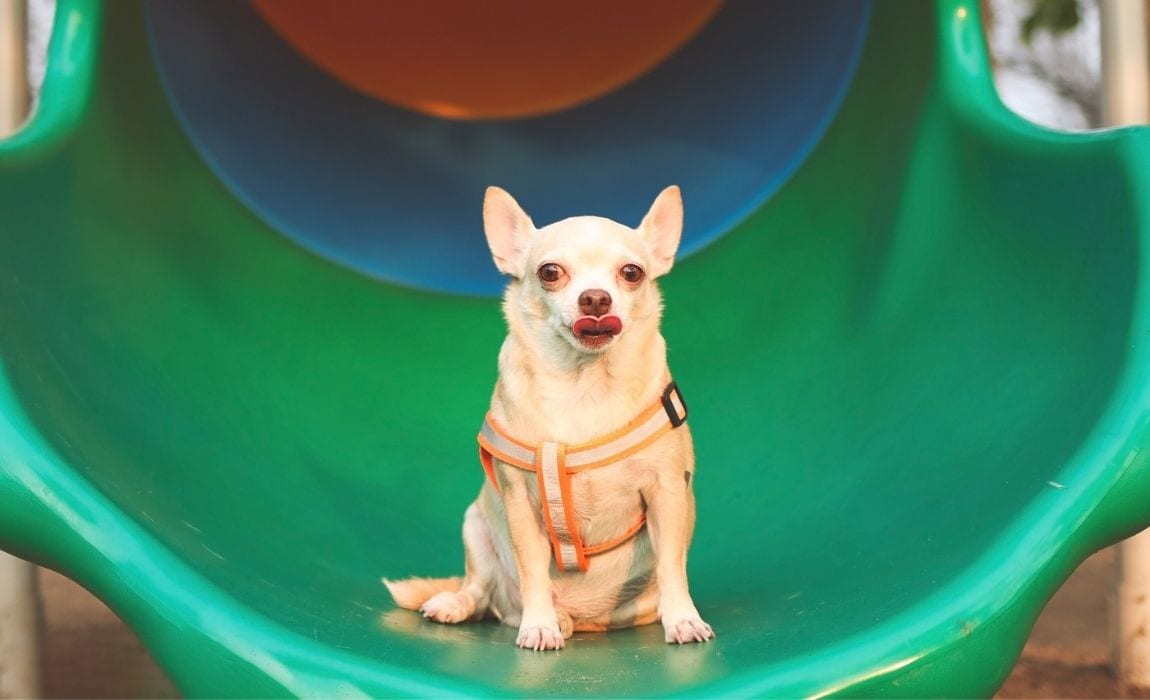




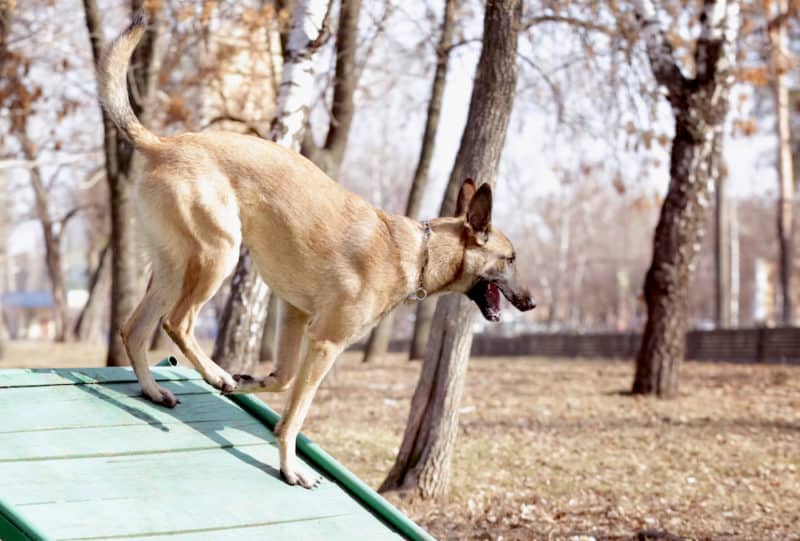
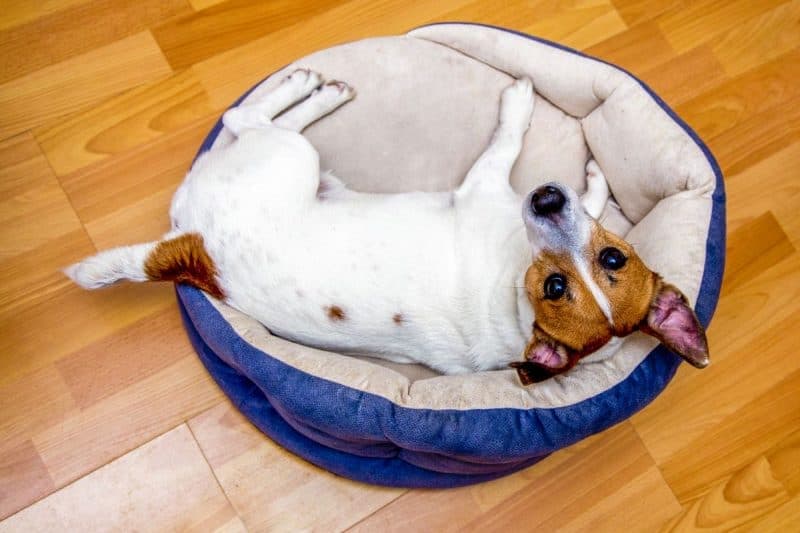
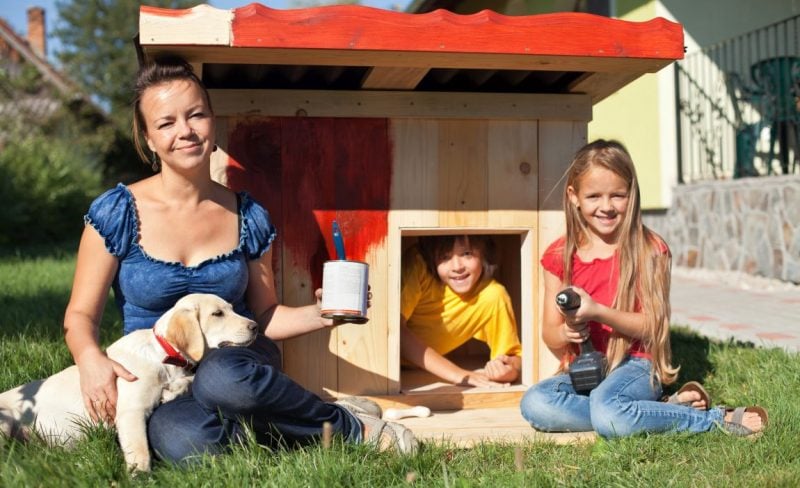
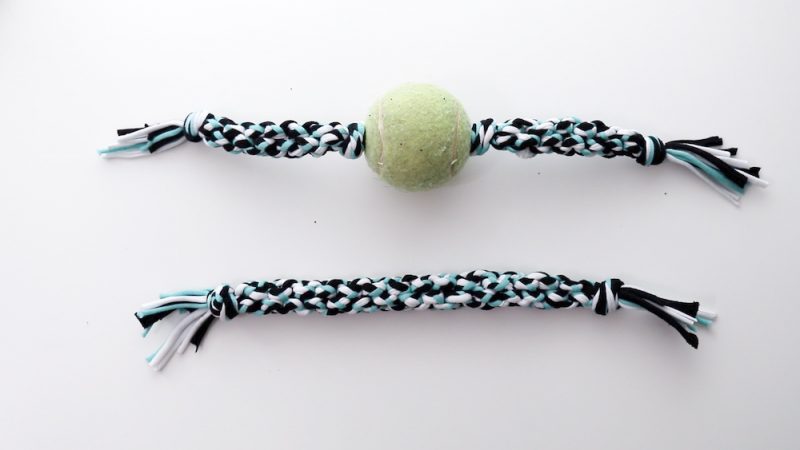
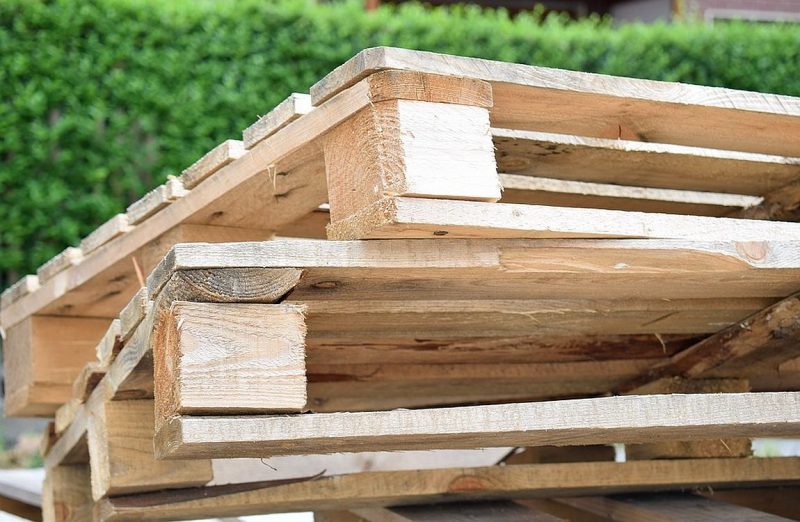
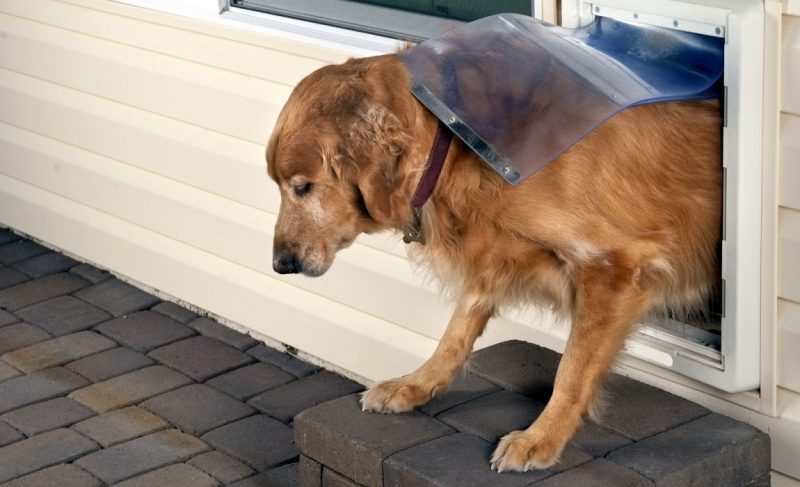
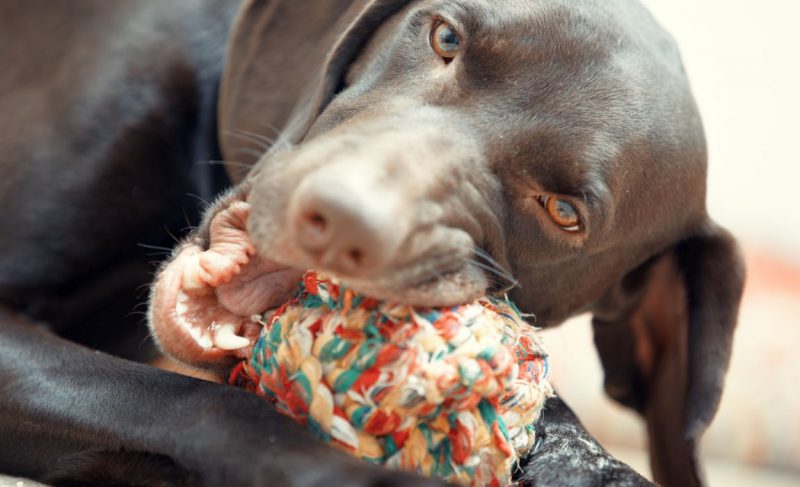

Leave a Comment